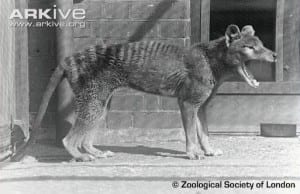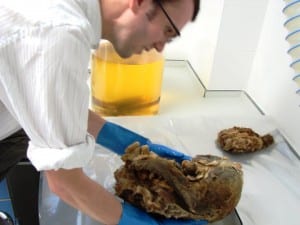Happy Thylacine Day: we haven’t learned – just look at the badgers
By Jack Ashby, on 7 September 2011
Picture this: an animal in a zoo dies of exposure one night because the door allowing it to return to the inside area of its enclosure was accidentally locked shut. It’s early Spring and southern Tasmania gets pretty cold – a wire and concrete cage is no place for a warm-blooded creature to be kept outside. Pretty awful, eh?
Well that’s what happened to the last known thylacine 75 years ago today. The neglect itself would be shocking for any individual, let alone the sole known member of a species – the only remaining taxon in an entire family of animals. That day, a whole branch of the tree of life fell off. Well, in truth it was cut off.
Thylacine lore
For anyone who is not (yet) a thylacine obsessive, they were the largest then-living marsupial carnivores and shaped very much like a dog with stripes over the backs and tails. They were also called Tasmanian tigers. They once ranged across New Guinea and mainland Australia, but disappeared there around 2000 years ago. Tasmania was their last refuge.
Thylacines are now on the logo of the island state (and one of it’s most popular beers), but this shows a significant change from the status with which they were held in the century prior to their extinction. Tasmania was attempting to build a sheep farming industry, but suffered heavily with loss of stock. At the time the powerful farming lobby blamed the thylacine, and successfully campaigned for a bounty to be placed on its head. The eventual extirpation that resulted from this government-endorsed slaughter is the only example of a deliberate extinction that I can think of.
That would be bad even if thylacines did impact on sheep-farming, but we now know that the evidence shows that they very rarely hunted sheep. In truth it was dogs which were allowed to run feral, and humans themselves stealing the livestock.
Echoes of the badger
At the moment the UK government are consulting on introducing a badger cull. Badgers are implicated in the spread of bovine tuberculosis, a terrible disease that affects a huge number of cattle at significant cost to farmers. Unlike the thylacine extinction, the vast majority of the British public are against the cull. This is partly because our sensibilities towards wildlife have changed since then and killing wild animals doesn’t sit well with most. A big part, however, is because the government’s own scientific advisers warn that it won’t solve the problem of TB in cattle, and could even make it worse.
So here we are once again, about to start funding the killing of animals for very bad reasons as a result of political pressure from a powerful farming lobby. The cull won’t result in badger extinction, I’m sure, but it would simply be wrong. To sign the petition to stop the cull, click here.
The thylacine fanclub
The circumstances of the thylacine’s demise is not the only remarkable thing about the whole topic. Their story certainly didn’t end on 7th September 1936. Since then they have recruited a huge and passionate fan-base. I know very many people, ranging from leading biologists (which most people tend to take very seriously) to full-time cryptozoologists (which undeniably haven’t enjoyed the same level of credibility, though do have a thylacine on their logo) who are convinced they still exist, wandering the island’s remote ecosystems. Some even think that there is a government conspiracy bent on concealing their survival: if they were proved to exist then their habitats would have to be protected against logging – one of the State’s major industries.
I myself am not a believer (though I will admit to a healthy amount of doubt) that thylacines still live in Tassie – it’s a tiny island and a carcass would probably have turned up by now (that said foxes are almost definitely on the island and it’s been amazingly hard to prove that). But that doesn’t mean I’m not a BIG fan.
As I said in one of my monthly New Scientist blog posts, the recent experience I had of actually removing our thylacine dissection preserved in fluid (pickled?) from its jar was a highlight of my career. I’ve been to Tasmania a number of times on fieldwork and holiday and it is one of the most amazing places on the planet. Just to be camping out in an area we know they once lived is a thrill. For months around each trip I have dreams of seeing them, and play out the sequence of events that would result from such an encounter. Once, whilst camping in a very remote region I dreamt I was awoken by one sniffing round my head. In the morning it was a good ten minutes of half-consciousness before I realised it wasn’t real. The come-down was massive.
Tonight my thylacine geek friends and I will be cele-mourning this amazing creature and the 75 years since it was last (officially) seen by raising a glass or two. Just as I did last month for Quagga Day, I ask that you take some time, shed some tears and put bottoms up for the innocent victim of a political extinction.
4 Responses to “Happy Thylacine Day: we haven’t learned – just look at the badgers”
- 1
-
2
Tim Causer wrote on 17 November 2011:

Brilliant stuff. The looping video of the thylacine at the Tasmanian Museum and Art Gallery is one of the saddest things I’ve seen.
-
4
Happy 78th Thylacine Day: Remember the little guys | UCL UCL Museums & Collections Blog wrote on 7 September 2014:

[…] importantly. to Grant Museumers, it’s Thylacine Day. Both of these events commemorate the ludicrously avoidable death of the last known thylacine – modern times’ largest marsupial carnivore – on 7th September 1936. Today, for the […]
 Close
Close




loving this blog! thanks for a great and informative start to the day!